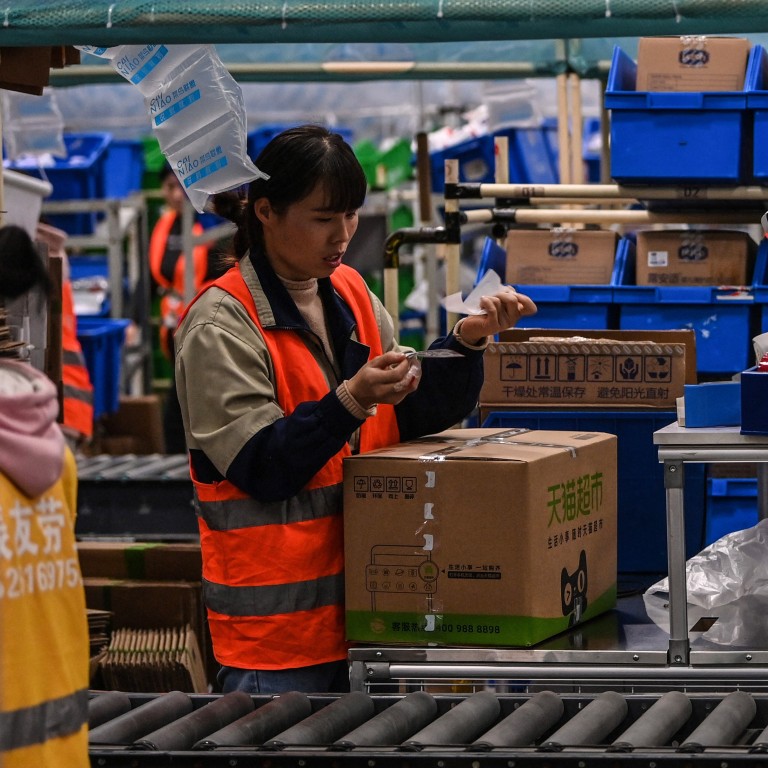
Why is China’s economic outlook raising alarms after August’s non-manufacturing PMI plunge?
- Chinese authorities blame weak economic sentiment on Delta outbreaks and floods, but analysts say there’s more to the picture
- China’s official composite purchasing managers’ index fell to the lowest point since coronavirus lockdowns began in February 2020 – marking a rare dip into the contraction range
Temporary shocks caused by Delta variant outbreaks may have been to blame for depressing China’s economic sentiments in the past month, but economists warn that the latest falling purchasing managers’ indices signal further problems in the economy.
And they are calling for more loosening of liquidity and increased fiscal spending.
China’s official composite purchasing managers’ index (PMI), which gauges sentiment in both manufacturing and the services industry, dropped sharply to 48.9 in August from 52.4 in July, data from the National Bureau of Statistics (NBS) showed on Tuesday. A reading above 50 indicates growth in sector activity, while a reading below the watershed mark represents contraction. The lower the reading is below 50, the faster the pace of contraction.
As the latest wave of Covid-19 appears to have been brought under control, companies in both the manufacturing and services sectors were optimistic on their development outlook in the official survey, the NBS said.
However, observers said there was more to the picture.
“Given China’s zero-tolerance coronavirus strategy and the potential for much more infectious variants of Covid-19, the services sector could be hit again in the coming months,” Lu Ting, chief China economist at Nomura, said in a note on Tuesday. However, he expected the non-manufacturing PMI to rebound into the expansion range in September.
The non-manufacturing PMI sharply cooled to 47.5 in August from 53.3 in July, serving to drag down the composite figure.
The slowdown was driven by a steep fall in the services index, from 52.5 to 45.2, attributed to coronavirus restrictions being reimposed and consumers becoming more cautious, according to the NBS.
Meanwhile, the manufacturing PMI edged down only slightly in August to 50.1 from 50.4 in July, meaning that the industry was still expanding, albeit by the narrowest of margins. And that reading still fell short of the 50.2 expected by the market.
Contracting sub-indexes of new orders and export orders also showed further softening demand in both domestic and overseas markets.
The job market and residential income have not returned to the pre-Covid-19 growth trajectory
“The weak manufacturing PMI likely indicates more persistent pressure the economy faces, as the property cycle cools down,” Zhang Zhiwei, chief economist at Pinpoint Asset Management, said in a note on Tuesday.
Nomura’s Lu agreed that China’s growth slowdown in the second half of 2021 could be “quite notable” due to the Delta variant, cooling property markets, slowing exports, and the national campaign to reduce carbon emissions.
He also expected the official manufacturing PMI to remain low, around 50.0, in September.
China’s recovery in consumption of goods and services has been criticised for lagging behind the curve since becoming the first major economy to rebound from the impact of the coronavirus, although the country is trying to rely more on its domestic consumer market as part of its so-called dual-circulation strategy.
“The job market and residential income have not returned to the pre-Covid-19 growth trajectory,” Wang Tao, chief China economist at UBS Investment Bank, said at a press conference on Tuesday.
She expected the annual growth rate of consumption to stay lower than that of the economy, adding that consumption might not catch up until the second half of next year.
But Wang said that Chinese authorities were likely to relax fiscal policies by stepping up the issuance of local government bonds to offset the negative impacts of the pandemic.
According to an estimation by Northeast Securities on Monday, about 1.7 trillion yuan (US$262.7 billion), or 49 per cent, of China’s special local government bonds quota had not been used by the end of August.
Thus, the growth of infrastructure investment in the coming months is expected to rebound moderately from the second quarter.
Both Lu and Zhang also agreed that Beijing was likely to ramp up fiscal spending, echoing a signal sent by the Ministry of Finance in a report at the weekend.
But ANZ Research chief China economist Betty Wang was less sanguine about the possibility of more fiscal spending.
The muted progress in local government spending has, thus far, been due to the slower issuance of special local government bonds (SLGB) – used for infrastructure spending – and any positive impacts on spending due to a further release of bonds would only be evident much later in the year, she said.
The shrinking qualified infrastructure project pool also limits the impact of fiscal spending, she added.
“As such, even if China’s fiscal spending and SLGB issuance pick up pace in the following quarters, we expect only a mild increase in investment and not a strong rebound,” Betty Wang said. “Market optimism about China’s fiscal support in the following months is overdone, in our view.”

